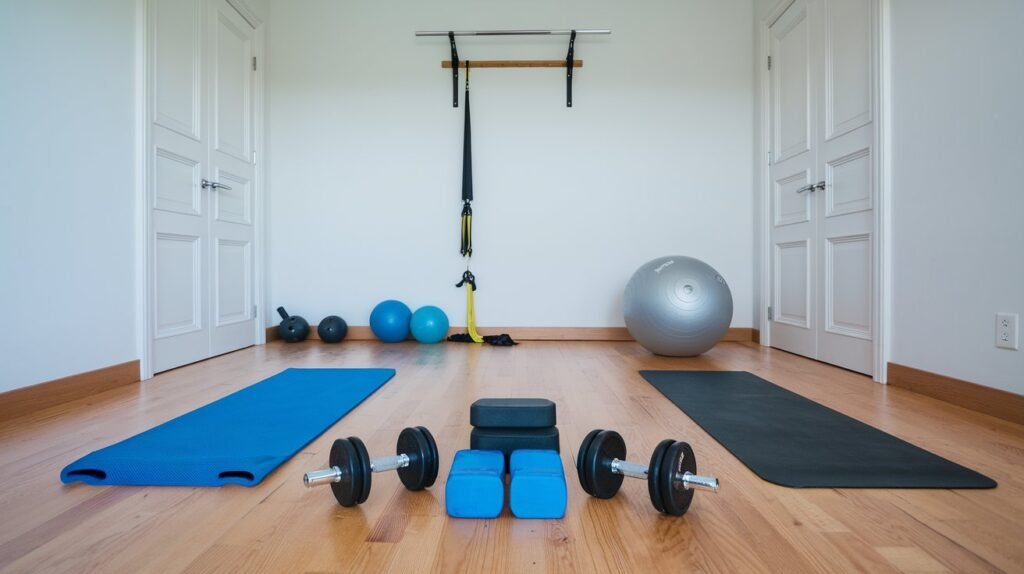Strength training is one of the most effective ways to build muscle, improve overall fitness, and increase longevity. For beginners, it can feel intimidating with all the information and exercise options. But with the right approach, anyone can start. We will explore everything you need to know to get started with strength training, from its benefits to beginner-friendly exercises. It’s designed to help you ease into this rewarding form of fitness, whether at the gym or working out from home.
Table of Contents
Introduction
Strength training, also known as resistance training, involves exercises that improve muscle strength and endurance. This can include lifting weights, using resistance bands, or performing bodyweight exercises. Unlike cardiovascular workouts, which focus on improving heart and lung health, strength training targets the muscles, bones, and connective tissues.
For beginners, it’s important to start slow and build up gradually. Proper form and consistency are the keys to avoiding injury and seeing long-term results.
Benefits of Strength Training for Beginners
Starting strength training provides a wide array of benefits that go beyond just looking toned. Here are some of the most impactful advantages:
- Increased Muscle Mass:
Muscle mass naturally declines with age. Strength training helps prevent muscle loss, allowing you to maintain functional movement as you get older. - Improved Metabolism:
Building muscle increases your resting metabolic rate, meaning you’ll burn more calories even when not working out. - Enhanced Bone Health:
According to the National Institute of Health, strength training can help increase bone density, reducing the risk of osteoporosis. - Improved Mental Health:
Strength training has been shown to reduce symptoms of anxiety and depression by releasing endorphins, the body’s natural mood lifters. - Better Functional Fitness:
Strength training improves balance, posture, and coordination, making everyday tasks easier and safer to perform.
Key Principles of Strength Training
Before you jump into your first workout, it’s important to understand some key principles that will set you up for success:
1. Progressive Overload
Progressive overload is the gradual increase in the weight, frequency, or number of repetitions in your workout. This is the foundation of building strength. Start with lighter weights and increase the load as you become more comfortable.
2. Proper Form
One of the most common mistakes beginners make is lifting too heavy too soon, which can lead to injuries. Focus on mastering form before increasing weights. This ensures you’re engaging the right muscles and prevents strain.
3. Rest and Recovery
Your muscles grow when they rest, not during the workout itself. Be sure to schedule rest days, and avoid overworking the same muscle groups two days in a row.
4. Balanced Routine
A balanced strength training routine targets all major muscle groups: legs, back, chest, shoulders, arms, and core. This promotes overall strength and prevents muscle imbalances.
Equipment Needed for Beginners

You don’t need a fully-equipped gym to start strength training. Here are a few pieces of equipment that can be used at home:
- Dumbbells:
Perfect for beginner strength training. Start with lighter weights (3-5 lbs) and gradually increase as you improve. - Resistance Bands:
Affordable and versatile, resistance bands can be used for many exercises and are ideal for home workouts. - Bodyweight:
Your body is the best tool. Exercises like squats, push-ups, and lunges require no additional equipment. - Kettlebells:
Great for dynamic movements like swings and squats that engage multiple muscle groups.
Basic Strength Training Exercises
Here are some beginner-friendly strength training exercises that can be done at home or at the gym. Aim to perform 2-3 sets of 8-12 repetitions of each exercise.
| Exercise | Primary Muscles Targeted |
|---|---|
| Squats | Quads, Hamstrings, Glutes |
| Push-Ups | Chest, Shoulders, Triceps |
| Planks | Core, Shoulders |
| Lunges | Quads, Glutes |
| Bent-Over Rows | Back, Biceps |
| Shoulder Press | Shoulders, Triceps |
1. Squats
Squats are essential for building lower body strength. Begin with bodyweight squats, focusing on proper form. Keep your back straight and knees behind your toes.
2. Push-Ups
Push-ups target your chest, shoulders, and triceps. If regular push-ups are too challenging, start with modified push-ups (knees on the floor).
3. Planks
Planks are excellent for core stabilization. Start by holding the position for 20-30 seconds and gradually increase the duration.
4. Lunges
Lunges work on your quads and glutes. Keep your front knee aligned with your ankle to avoid strain.
5. Bent-Over Rows
This exercise targets your back and biceps. You can use dumbbells or resistance bands for this movement.
6. Shoulder Press
Shoulder presses can be performed with dumbbells or resistance bands. This exercise builds shoulder and upper arm strength.

Sample Strength Training Routine for Beginners
Here’s a sample full-body routine that beginners can perform at home or in the gym:
| Exercise | Sets | Reps |
|---|---|---|
| Bodyweight Squats | 3 | 12 |
| Push-Ups | 3 | 10 |
| Bent-Over Rows (Dumbbell) | 3 | 12 |
| Lunges | 3 | 10 (each leg) |
| Shoulder Press (Dumbbell) | 3 | 10 |
| Planks | 3 | 30 seconds |
- Warm-up: 5-10 minutes of light cardio (e.g., jogging in place, jumping jacks).
- Cooldown: Stretch major muscle groups post-workout to improve flexibility.
Common Mistakes to Avoid
- Lifting Too Heavy Too Soon:
Always prioritize proper form over lifting heavier weights. Lifting too much too early can lead to injuries. - Skipping Warm-ups:
Always warm up before starting your strength training routine. This helps prevent muscle strains and injury. - Neglecting Rest:
Rest is crucial for muscle recovery. Without adequate rest, your muscles won’t have time to rebuild and grow stronger. - Not Progressing:
Progression is key to seeing results. As you become more comfortable with your routine, add weights or increase the number of reps.
Tracking Strength Training Progress

Tracking your progress in strength training is one of the most effective ways to ensure long-term success. By consistently monitoring your workouts and recording key metrics like weights lifted, repetitions, and sets completed, you can gain valuable insights into how your body is responding to the training. It also helps you identify areas where you may need to improve or push harder. Keeping track of your performance helps maintain motivation, allowing you to see how far you’ve come, even on days when progress feels slow.
One of the easiest ways to track your strength training progress is by using a workout journal or fitness app. Whether you’re performing bodyweight exercises, using dumbbells, or following a structured plan, writing down each session allows you to reflect on your progress over time. Documenting details such as the number of repetitions, weight lifted, and rest periods ensures that you’re continually challenging yourself and making adjustments to your routine when needed.
Tracking progress is also essential for goal-setting. Having tangible records of your workout routines allows you to set realistic, achievable goals, such as increasing the number of push-ups you can do or improving your squat strength. This not only keeps you focused but also prevents you from plateauing or becoming complacent in your training. Each small victory, like lifting an additional 5 pounds or completing an extra set, builds towards larger achievements, making the journey to better strength and fitness more satisfying.
Moreover, progress tracking helps prevent injury and overtraining. By reviewing past workouts, you can ensure you’re allowing adequate time for recovery, balancing intensity with rest days, and avoiding the temptation to push too hard too soon. This balance is vital for long-term strength gains and overall health. Progress tracking also lets you celebrate non-physical improvements, like better form, increased endurance, or greater mental resilience during workouts.
Ultimately, tracking your strength training progress isn’t just about numbers. It fosters a mindset of accountability, personal growth, and continuous improvement, all of which are essential components of a successful fitness journey.
Frequently Asked Questions (FAQs)
Q: How often should I strength train as a beginner?
A: For beginners, aim to strength train 2-3 times per week, targeting all major muscle groups. Ensure you have at least one rest day between workouts for the same muscle group.
Q: Can I combine cardio and strength training?
A: Yes! Cardio and strength training complement each other well. Many beginners start with a mix of both to improve overall fitness.
Q: How long will it take to see results?
A: Results depend on consistency and effort. Generally, beginners notice changes in strength within 4-6 weeks of consistent training.
Q: Do I need to lift heavy weights to see results?
A: No, lifting heavy weights is not required for beginners. Start with lighter weights and focus on mastering your form. You can gradually increase the load as your strength improves.
Conclusion
Strength training is an excellent way for beginners to build muscle, increase strength, and improve overall health. Whether you’re using dumbbells, resistance bands, or just your body weight, the key is consistency and proper form. Start slow, progress gradually, and you’ll see improvements in both your strength and confidence.
References
- National Institute on Aging. “Strength Training for Older Adults.” https://www.nia.nih.gov/health/strength-training
- Mayo Clinic. “Strength training: Get stronger, leaner, healthier.” https://www.mayoclinic.org/healthy-lifestyle/fitness/in-depth/strength-training/art-20046670
- American Heart Association. “Why Strength Training?” https://www.heart.org/en/healthy-living/fitness/fitness-basics/why-strength-training
- Harvard Health Publishing. “The surprising benefits of strength training.” https://www.health.harvard.edu/staying-healthy/the-surprising-benefits-of-strength-training




